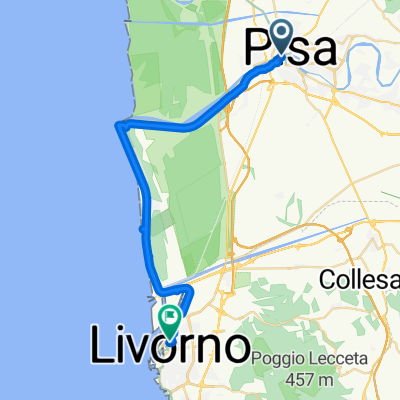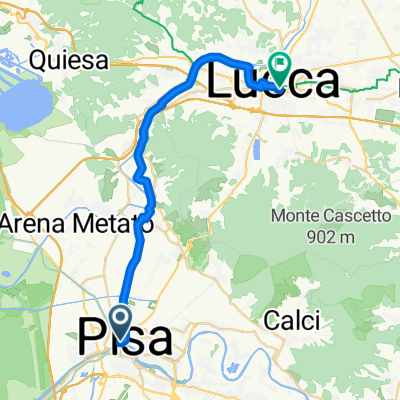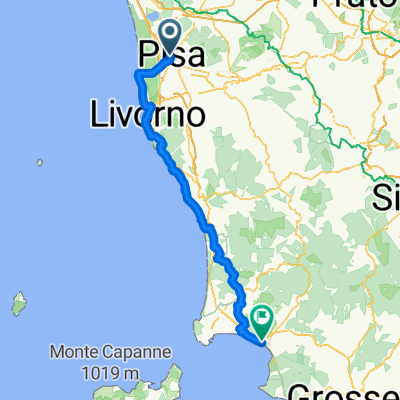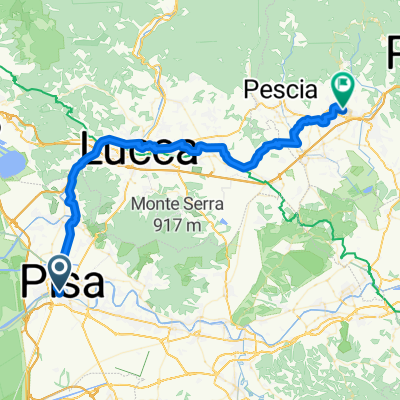- 9.8 km
- 4 m
- 7 m
- Pisa, Tuscany, Italy
Sard 17. Pisa
A cycling route starting in Pisa, Tuscany, Italy.
Overview
About this route
Trains to Pisa departing: 0800, 0812 ,0831, 0835, 0849, 0901, 0907, 0912, 0926, 0941, 0955 12-23min Pisa - San Miniato-Fucecchio Train departures: 0954, 1001, 1054, 1154, 1201, 1254 29-38min
- -:--
- Duration
- 6.9 km
- Distance
- 37 m
- Ascent
- 37 m
- Descent
- ---
- Avg. speed
- 13 m
- Max. altitude
created this 2 years ago
Route highlights
Points of interest along the route
Point of interest after 0 km
Trains to Pisa departing: 0800, 0812 ,0831, 0835, 0849, 0901, 0907, 0912, 0926, 0941, 0955 12-23min
Point of interest after 1.4 km
Chiesa di Santa Maria della Spina Small church built in the 1200s featuring an ornate gothic facade, many statues & a painted ceiling.
Point of interest after 1.6 km
Lungarni di Pisa Scenic spot
Point of interest after 1.8 km
National Museum of the Royal Palace Museo Nazionale di Palazzo Reale di Pisa
Point of interest after 2.1 km
Palazzo della Sapienza
Point of interest after 2.3 km
Palazzo del Consiglio dei Dodici The palace changed its name over time according to the judiciary it hosted: from the Palazzo dell'Archivio and the Cancelleria in the Middle Ages to Palazzo dei Priori after the Florentine conquest (1409) to Palazzo del Consiglio dei Dodici when it passed into the hands of the Order of the knights of Santo Stefano; the Council of Knights of twelve chosen members was in fact a decision-making body of the Order. At the end of the sixteenth century the palace was renovated by the architect Pietro Francavilla (also author as sculptor of the Statue of Cosimo I in front of the nearby Palazzo dei Cavalieri), who uniformed it to the surrounding buildings for height and style of late Renaissance style decorations. The frieze on the cornice recalls how the works were completed in 1603 under the Grand Duchy of Ferdinando I de 'Medici. The transition to the chivalric order took place only in 1691, when the priors moved to Palazzo Gambacorti: here the knights established their court, as the inscription on the main portal also reminds. The facade is now characterized by a pink plaster on which the white marble decorations stand out: the window frames, the portal flanked by two columns, the balustrade openings on the main floor, the string course frames, the coat of arms, the corner reinforcements and the cornice . Inside there are numerous works of art, such as the sixteenth-century bust of Ferdinando I, the fresco fragment of the Assumption of the school of Domenico Ghirlandaio (in the hall of the Coats of Arms on the first floor) and above all the Hall of the Audience, with walls completely painted by Pietro Paolo Lippi and Antonio Giusti (1681-1683) with marine themes and the remarkable carved, gilded and painted ceiling with the cardinal virtues of Ventura Salimbeni (1602); today in the center of the ceiling of the room is the Triumph of Saint Stephen by Giovanni Camillo Gabrielli (1692), which replaced Salimbeni's Triumph of Pisa after the building became the property of the Order.
Point of interest after 2.3 km
Piazza dei Cavalieri Renaissance square with a statue of Cosimo I de Medici, the first Grand Duke of Tuscany.
Point of interest after 2.4 km
Torre della Muda an ancient medieval tower of Pisa, known since it was the place where Ugolino della Gherardesca and his sons and nephews were imprisoned and left to die of hunger; episode also quoted by Dante in the XXXIII canto of the Inferno. After the dramatic events of Ugolino, well known at the time even before they were mentioned by Dante Alighieri, the Count of Gherardesca being a well-known and politically important person, the tower was nicknamed the Fame. The name Torre della Muda derives, instead, from the fact that in the past here the eagles bred by the municipality of Pisa were kept during the period of the feathers. History and description Edit The tower was located in Piazza delle sette vie, now Piazza dei Cavalieri di Santo Stefano, and was incorporated into the Clock Tower, where the Captain of the People lived at least since 1357. It is recognizable on the left side of the building where there is also a tombstone that remembers the sad episode that made it famous: you can still see the stone outline of the tower to the left of the central arch. The right side of the building was the Palazzo del Capitano del Popolo. In the tower after 1919 the quadrifora was opened in neo-gothic style. Even from inside the arch you can see the remains of a wall of the ancient tower. Currently it houses the library of the Scuola Normale Superiore.
Point of interest after 2.9 km
Fontana dei Putti
Point of interest after 3.1 km
Battistero di San Giovanni Large medieval baptistery praised for its acoustics, with panels by renowned sculptor Pisano.
Point of interest after 3.2 km
Cattedrale di Pisa Grand marble-striped cathedral known for its ornate Romanesque bronze doors & carved 1300s pulpit.
Point of interest after 3.4 km
Leaning Tower of Pisa Torre di Pisa Elaborately adorned 14th-century tower (56 meters at its tallest point)
Point of interest after 3.9 km
Porta a Lucca
Point of interest after 3.9 km
Baths of Nero Bagni di Nerone The Baths of Nero (Italian - Bagni di Nerone) are an archaeological site near the Porta a Lucca in Pisa, then the Roman city of Colonia Pisana. Now below street level, they are the only Roman remains still standing in the city and form a thermae complex. History They were given the misnomer 'of Nero' in the medieval period, when they were believed to have been part of a palace - the earliest level actually dates to the final decades of the 1st century, during the reign of Domitian, as suggested by the use of the opus vittatum mixtum building technique with alternating layers of brick and tuff blocks. It was rebuilt during the 2nd century, as evidenced by an inscription (CIL XI, 1433, now held in National Museum of San Matteo) which cites the Veruleii Aproniani family,[1] well-known for owning extensive grounds and ceramics factories. In particular Lucius Venuleius Apronianus Priscus financed the rebuilding.[2] He was a patronus of Roman Pisa and consul of Attidium (a Roman city near present-day Fabriano), who held a number of offices in the Antonine period. As was typical of public figures in the Roman world, he funded several building projects: in 92 he built the Caldaccoli Aqueduct and also funded a building in Corliano. The best-preserved part of the complex is the laconicum (hot room), composed of an octagonal room with an apse, with a dome-shaped perforated roof, which has been partially restored. There are also the remains of some of the walls of the palaestra of the apodyterium and two walls from the tepidarium. Marble remains and some decorative sculptures have also been found. Its water was supplied by the nearby river Auser and from the Caldaccoli aqueduct. They were re-discovered and restored in the 16th and 17th centuries by command of Cosimo III, excavated in 1881 by Clemente Lupi, fenced off in 1938 (after the demolition of some neighbouring houses) and finally fully restored in 1947.[3] A covering dome was installed but this was worn out by the weather by 2007, when it was replaced.
Point of interest after 4.7 km
Parish of St Francis Parrocchia di San Francesco
Point of interest after 5.2 km
Palazzo Medici On an 11th century structure, it takes on the form of a royal palace in the 13th century. Located in Lungano Mediceo, in Piazza Giuseppe Mazzini, very close to the National Museum of San Matteo. Over the centuries, between reforms, modifications and restorations, it conserves part of the Gothic style in its architecture. However, it was revitalized and its architectural features blended with other styles, until it reached the Renaissance. The former Palazzo Appiano (original name) was acquired in 1446 by the Medici family. For some time now, the palace has been home to the seat of the Prefecture of Pisa.
Point of interest after 5.9 km
Fortress of pisa Fortezza di Pisa
Point of interest after 6.6 km
Monumento a Vittorio Emanuele II
Point of interest after 6.6 km
Chiesa di Sant'Antonio abate 14th-century church rebuilt after WWII, known for its exterior mural by pop artist Keith Haring.
Point of interest after 6.9 km
Pisa - San Miniato-Fucecchio Train departures: 0954, 1001, 1054, 1154, 1201, 1254 29-38min
Continue with Bikemap
Use, edit, or download this cycling route
You would like to ride Sard 17. Pisa or customize it for your own trip? Here is what you can do with this Bikemap route:
Free features
- Save this route as favorite or in collections
- Copy & plan your own version of this route
- Sync your route with Garmin or Wahoo
Premium features
Free trial for 3 days, or one-time payment. More about Bikemap Premium.
- Navigate this route on iOS & Android
- Export a GPX / KML file of this route
- Create your custom printout (try it for free)
- Download this route for offline navigation
Discover more Premium features.
Get Bikemap PremiumFrom our community
Other popular routes starting in Pisa
- Via di Putignano Sant'Ermete, Pisa a Via Centro Rai, Pisa
- Lungarno Gambacorti nach Via Borra
- 30.4 km
- 10 m
- 74 m
- Pisa, Tuscany, Italy
- 2015 Tuscany Travel
- 481.2 km
- 2,248 m
- 2,245 m
- Pisa, Tuscany, Italy
- Toskana Rundfahrt 2008
- 464.2 km
- 2,587 m
- 2,587 m
- Pisa, Tuscany, Italy
- Via Santa Maria nach Via dell'Angelo Custode
- 25.3 km
- 86 m
- 70 m
- Pisa, Tuscany, Italy
- Von Pisa bis Follonica
- 133.1 km
- 1,337 m
- 1,334 m
- Pisa, Tuscany, Italy
- Viale Galleria Antonio Gramsci, Pisa to Viale Giuseppe Verdi, Montecatini-Terme
- 58.8 km
- 284 m
- 258 m
- Pisa, Tuscany, Italy
- in tutta italia
- 520.4 km
- 2,375 m
- 2,370 m
- Pisa, Tuscany, Italy
Open it in the app










